Key takeaways:
- Foster-to-adopt programs allow potential pet owners to assess compatibility with animals, reducing the stress of the shelter environment and leading to fewer returned adoptions.
- Engaging in fostering provides a nurturing home for animals, revealing their unique personalities and fostering empathy in caregivers.
- Challenges include emotional attachments and logistical issues, requiring patience, careful planning, and a strong support system for foster caregivers.
- Establishing routines and seeking support from fellow caregivers enhances the transition for both the foster animal and the caregiver.
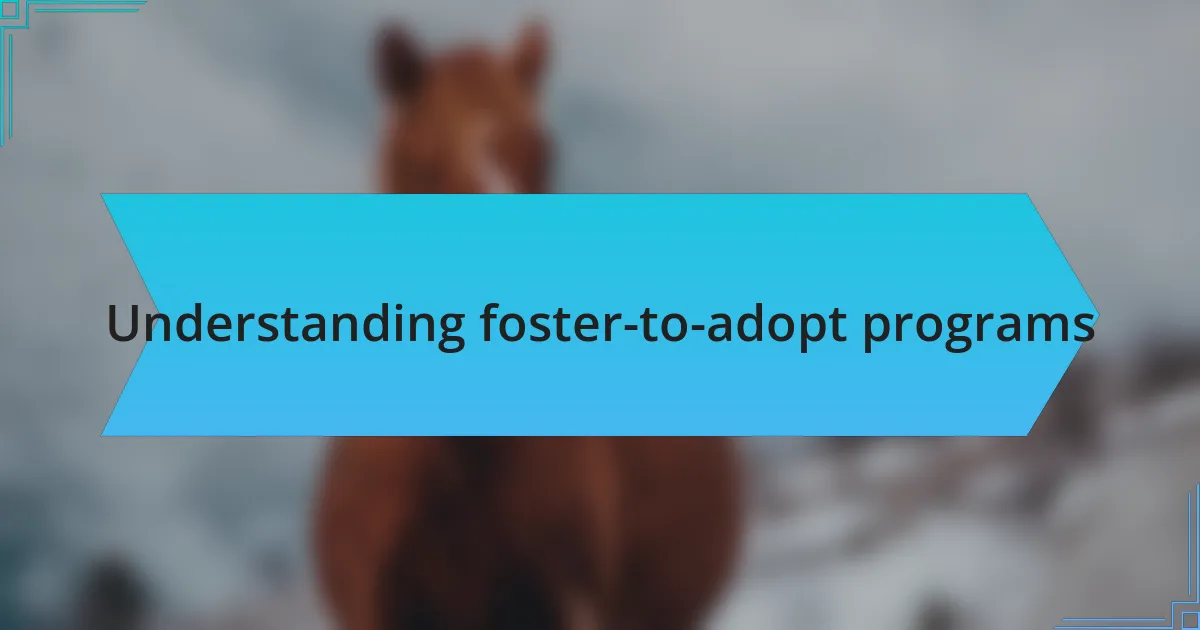
Understanding foster-to-adopt programs
Foster-to-adopt programs serve as a bridge between temporary care and a permanent home for animals in need. I distinctly remember a moment when I witnessed a young couple fostering a timid puppy. They shared how each day brought new challenges, but also increased joy as the puppy began to trust them. Isn’t it amazing how that bond can develop, sometimes in just a matter of weeks?
Engaging in a foster-to-adopt program allows potential pet owners to assess compatibility with an animal before making a lifelong commitment. From my experience, this is crucial—what works in a shelter environment doesn’t always translate to home life. Have you ever thought about how a slight adjustment in routine could change an animal’s behavior?
Moreover, these programs help shelters manage overcrowding while giving animals a taste of homelife. I can’t help but feel a surge of hope when I see an animal thrive in a home setting, knowing that every small step makes a significant difference. It’s not just about finding a pet; it’s about creating and nurturing a bond that could last a lifetime.
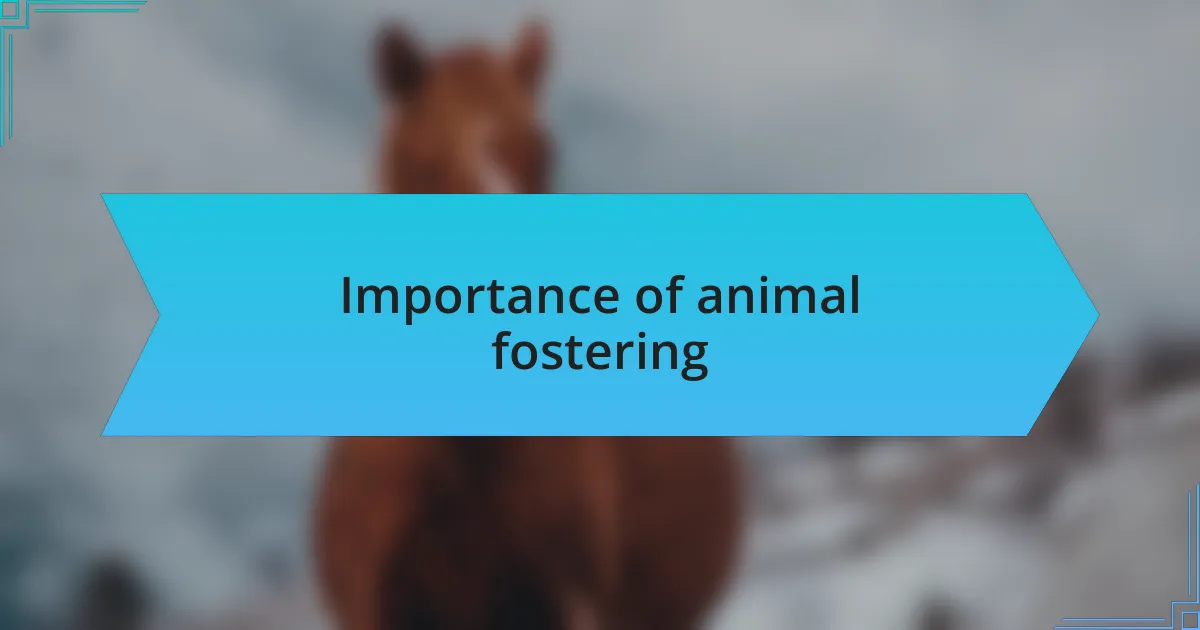
Importance of animal fostering
Fostering animals is essential because it provides them with a safe and nurturing environment to thrive outside of a shelter. I vividly recall fostering a playful tabby cat who quickly transformed from a frightened little creature to a confident companion, curling up beside me every evening. Isn’t it fascinating how the warmth of a home can encourage an animal to shed their fears?
When I reflect on my time as a foster caregiver, I realize that nurturing these animals often reveals their unique personalities. One puppy I fostered loved to chase after his own tail, bringing endless laughter and a sense of joy to my household. Have you ever experienced how the simple antics of a pet can brighten even the darkest days? This connection fosters empathy and understanding, both for the animals and ourselves.
Moreover, fostering plays a pivotal role in educating potential adopters about animal needs. I remember having conversations with friends who were curious about adopting and how my experiences shaped their perceptions. Each story I shared highlighted not just the animals’ quirks and needs but also the deeper bond that develops during the fostering journey. Isn’t it gratifying to think that by sharing these moments, I could inspire someone to welcome a furry friend into their home?
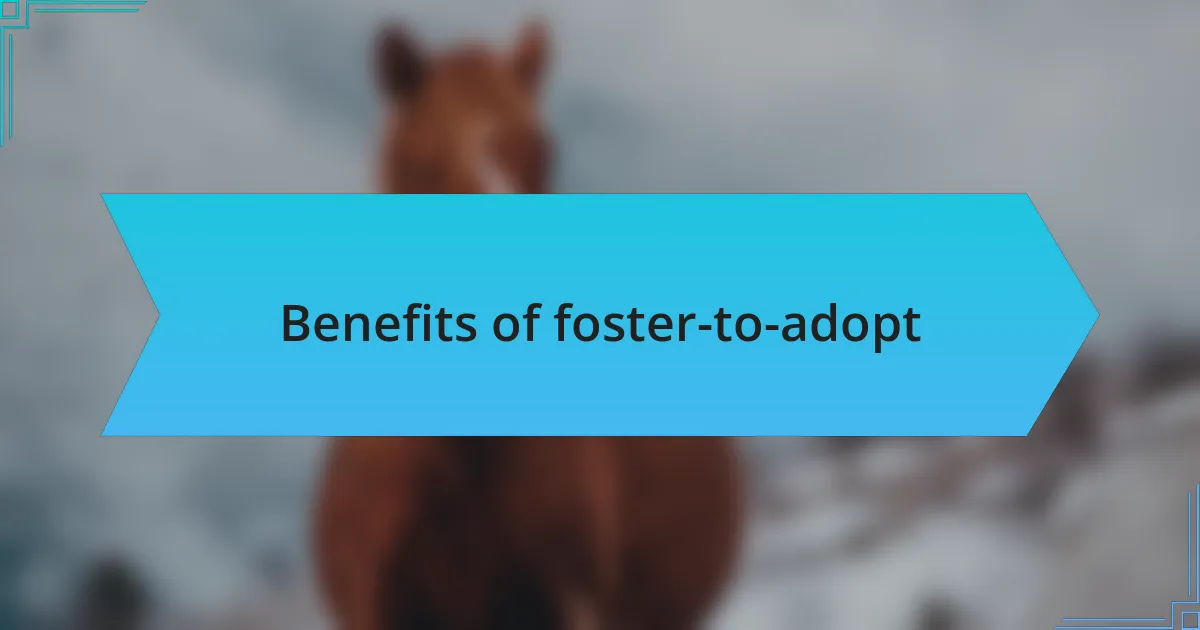
Benefits of foster-to-adopt
Foster-to-adopt programs come with the invaluable benefit of allowing families to get to know a pet’s personality before making a permanent commitment. I remember when I decided to foster a young dog who initially seemed shy and withdrawn. Over the weeks, as he grew comfortable, his playful side emerged, filling my home with happiness. Isn’t it wonderful how this gradual process can help both the pet and the adopter find their perfect match?
Another significant advantage of foster-to-adopt is that it helps reduce the stress animals often experience in a shelter environment. When I transitioned from fostering to adopting a senior cat, I noticed how much more relaxed she became in our home. Her transformation was a reminder of how critical a stable environment is for an animal’s well-being. Can you imagine the relief a pet feels when they finally find their safe haven?
Finally, foster-to-adopt programs can lead to fewer returned adoptions, benefiting both the animals and shelters. My own experience taught me that spending time with a pet in a foster setting builds a deeper understanding of their needs and quirks. Reflecting on this, I realize how vital it is for families to approach adoption with the knowledge gained during this fostering period. Wouldn’t it be wonderful if every adoption could start with this thoughtful foundation?
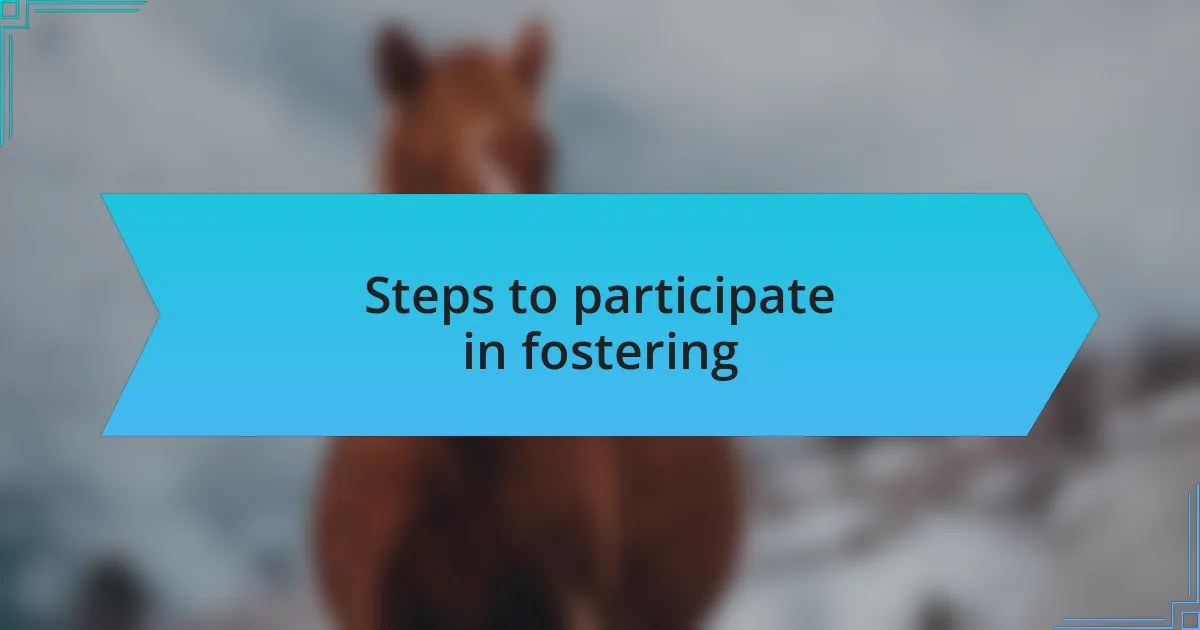
Steps to participate in fostering
To participate in fostering, start by reaching out to your local animal shelter or rescue organization. When I took this first step, I felt a combination of excitement and nervousness. Would they be open to me? But I quickly learned that shelters are often eager for foster volunteers, and they provided me with all the information I needed to begin the journey.
Next, be prepared for an application process that typically includes filling out forms about your living situation and experience with pets. I remember sitting at my kitchen table, reflecting on my past animal experiences—each moment shaped my desire to help. This step allows organizations to ensure each foster home is a good fit for the animals they’re placing; after all, the goal is to create a happy environment for both foster caregivers and pets.
Finally, consider attending an orientation session where you can learn more about fostering guidelines and responsibilities. I still recall that first meeting, filled with strangers sharing a passion for animal welfare. It was enlightening to connect with others and gain insights into what life as a foster parent truly entails. What better way to prepare for the rewarding experience ahead than to bond with fellow animal lovers who share your enthusiasm?
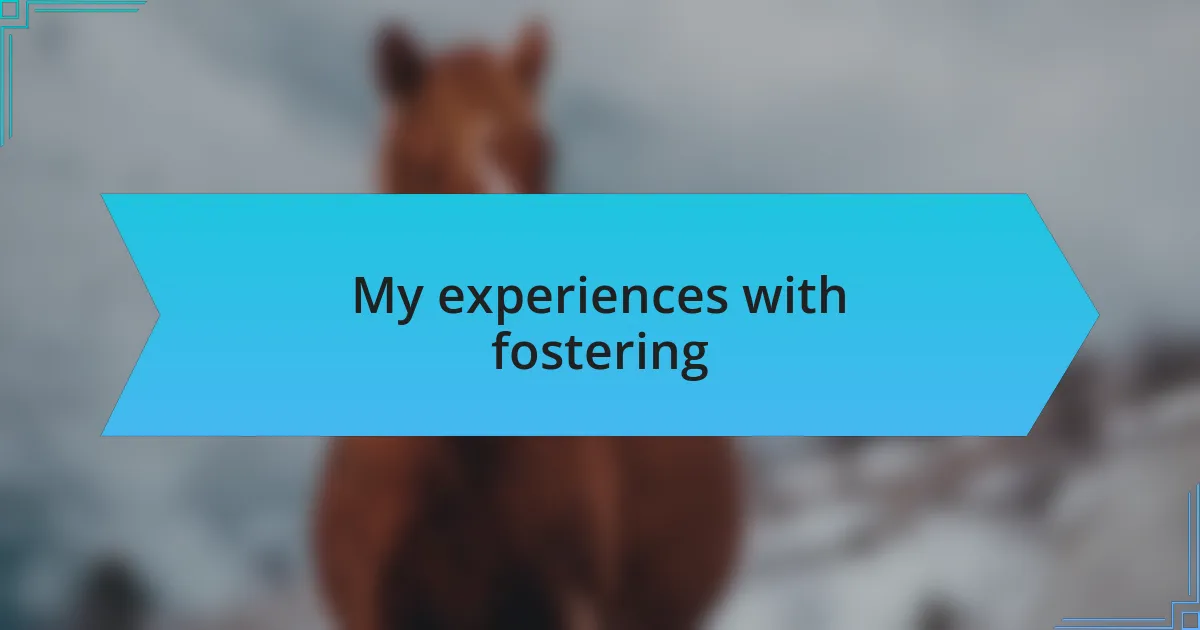
My experiences with fostering
Fostering has been one of the most fulfilling experiences of my life. I remember the first time I welcomed a timid puppy into my home; she hid under the couch for days. It was heartbreaking to see her so scared, but over time, with patience and love, she blossomed into a confident little companion. That transformation reminded me how crucial a safe and nurturing environment can be for an animal in need.
One of the most unexpected joys has been witnessing the unique personalities of each animal. I fostered a goofy kitten who had the quirkiest habit of chasing her tail in circles. I couldn’t help but laugh, feeling a deep connection as she brought so much light and laughter into my home. Isn’t it amazing how these creatures, despite their past hardships, can teach us about resilience and joy?
There were challenges as well. Once, I had a dog who was incredibly anxious, barking at every sound. As I navigated his fears, I found myself learning about compassion in ways I never anticipated. It dawned on me that fostering is as much about helping them heal as it is about finding them a forever home; each experience is a lesson in empathy that I cherish deeply.
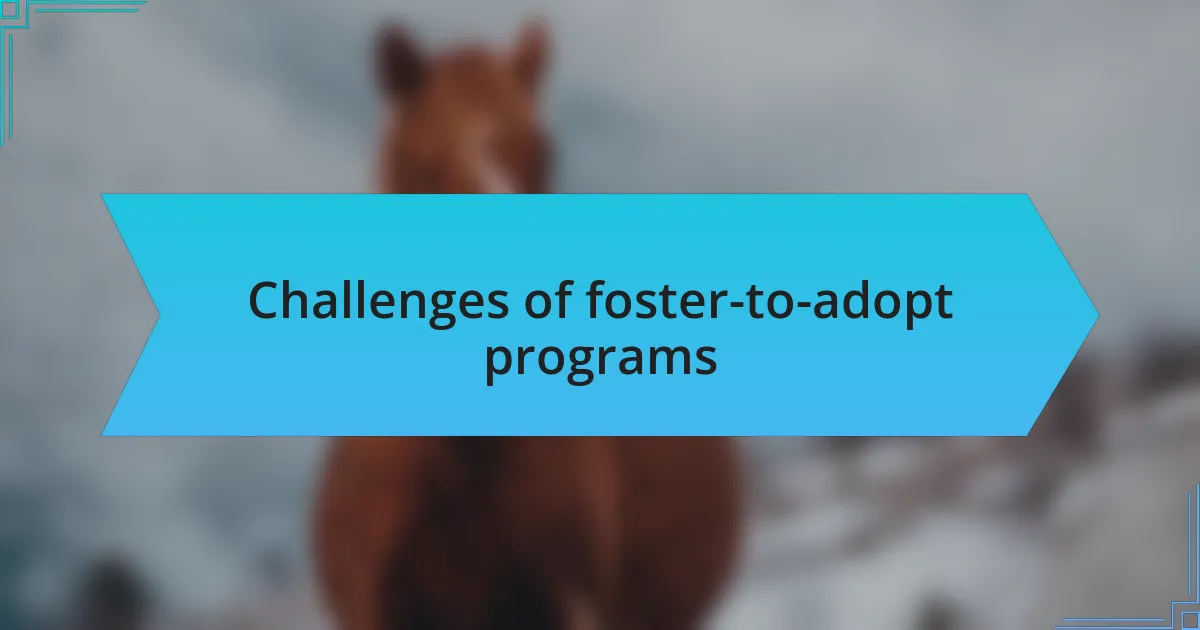
Challenges of foster-to-adopt programs
Navigating the challenges of foster-to-adopt programs can be complex. I once fostered a puppy who developed a strong attachment to my family. It was heart-wrenching when I finally had to let her go; the emotional bond we formed left a significant mark on my heart. How can I prepare for that kind of farewell? Understanding the commitment emotional investment required is crucial before diving in.
Additionally, not all foster animals adjust easily to new environments. I had a cat who took weeks to come out of hiding, which was difficult not just for her but for me too. Watching her retreat when I approached was a painful reminder of the trauma some animals carry. It made me realize that patience isn’t just a virtue; it’s a necessity in fostering, especially in a system where you want them to feel comfortable while finding them a loving home.
Moreover, the logistics involved can often be overwhelming. I recall the financial pressures of unexpected veterinary bills; they were a stark reminder that fostering involves more than just love and care. Balancing these responsibilities with the emotional highs and lows of fostering can feel like walking a tightrope. So, how do we manage to support these animals while taking care of ourselves? It’s a reminder that fostering, while rewarding, requires careful planning and resilience.
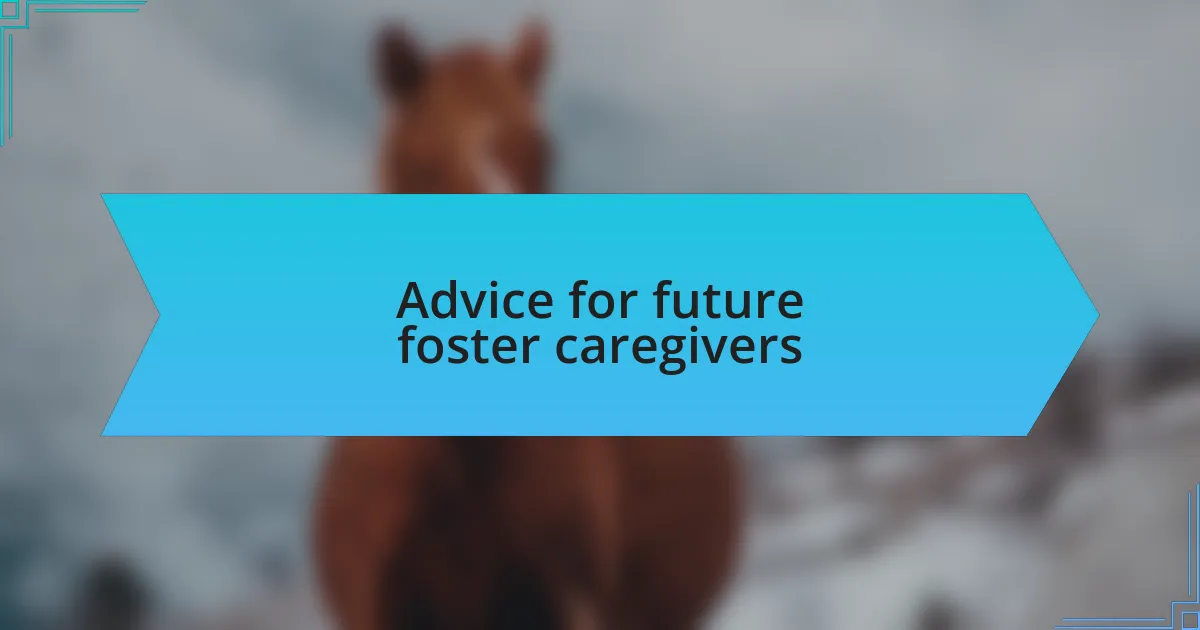
Advice for future foster caregivers
When considering becoming a foster caregiver, it’s important to prepare yourself mentally and emotionally. I remember one evening, after a long day, I encountered a scared little dog who cowered in the corner. I realized then that fostering isn’t just about providing a bed; it’s about creating a safe space for them to heal. Have you thought about how you would handle such situations?
Establishing a routine can be incredibly beneficial for both you and the foster animal. I found that by sticking to regular feeding and exercise times, the animals quickly felt more secure. Structure gave them comfort amidst any chaos. If you could experience that sense of stability, wouldn’t it enhance the bond you share?
Lastly, don’t hesitate to reach out for support. I recall connecting with other foster caregivers through online forums, and their shared experiences proved invaluable. We swapped stories, advice, and sometimes a good laugh about the absurdity of pet antics. Isn’t it comforting to know you’re not alone in this journey? Having a network can make all the difference when the going gets tough.